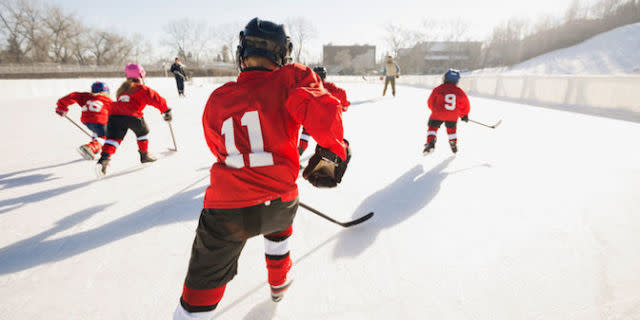Some People Think Contact Sports Are "Abusive." Here's Why I Let My Kid Play Them, Anyway.

Not even 5 feet tall and no more than 80 pounds soaking wet, my 10-year-old daughter was not the sort of hulking brawler you're used to seeing on the ice. But when she asked if she could play hockey, it wasn't her gender or her size that gave me pause. It was her brain.
Hockey is one of the most dangerous contact sports - even more dangerous than football, according to a recent study. I knew by sending my daughter out onto the ice, I was putting her at risk for bruises, broken bones, and even more serious injuries, like concussions.
Dr. Bennet Omalu, the forensic pathologist made famous in the Will Smith movie Concussion, has gone so far as to compare youth sports like hockey to child abuse. Omalu is the doctor who discovered chronic traumatic encephalopathy (CTE), a form of brain damage linked to too many concussions that, years after injury, can lead to memory loss, depression, and even dementia and suicidal behavior.
Still - even knowing the risks involved - I said yes.
Watching her on the ice, helmet dwarfing her tiny head, wrapped in enough padding to put the StayPuft marshmallow man to shame, I realized I'd made the right choice. She wasn't in any more danger on the ice than she was swinging from the top of the swingset in the local park. Not coated in that many pads, not with safety-conscious coaches around, not at 10 with other 10-year-olds playing in a league for kids. The NHL this was not.
My daughter's hockey career was brief. Living in a small town meant we'd have to drive an hour and a half each way for her to join a girls' league, and after a few trips to the rink, she decided it wasn't worth the time. I'd say it was a relief, but she's chosen soccer as her sport instead, a game that's often considered "safer" by parents than hockey, football, or boxing. Ironically, they're wrong: Studies have found that concussions sustained during soccer matches send a shocking number of kids to the ER every year. And concussion rates in soccer are on the rise, especially among young female players.
No parent can ever guarantee that their kid won't experience danger.
And yet I let her play. Not because I'm abusive. Not because I doubt the veracity of concussion studies or how dangerous concussions can really be - I had one after a car accident in my teens, so I know firsthand what they can do to you (for a few weeks afterwards, I suffered from fatigue, nausea, and headaches). And I'm lucky I didn't suffer any repeats: One concussion puts the brain at risk for more, and repeated concussions through the years can result in the type of irreversible brain damage that leads to CTE.
As much as all of this still sometimes makes me wish I could swaddle my daughter in bubble wrap, I still allow her to play because no parent can ever guarantee that their kid won't experience danger. Now 12, my daughter's worst injury didn't happen in the rink or on the soccer field, but in the supposed safety of our own living room, where she was attacked by a dog. Dozens of stitches and thousands of dollars in medical bills later, she's OK. And I'm all the more determined to allow her to take reasonable risks with reasonable protections, so she can learn to test her limits.
Kids get hurt. They fall down. They do daredevil moves high atop the monkey bars. You can't stop them from getting hurt - you can only do the best you can to mitigate the damage. You outfit them with pads and helmets in hockey or shin guards and goalie gloves in soccer. You learn the signs of what a concussion entails, and you take injuries seriously.
But in the end, youth sports are supposed to be about having fun. So long as she's having fun, and not showing any ill effects, she can play.
That's not child abuse. That's letting a child have a childhood.
Follow Redbook on Facebook.
You Might Also Like

